TOP 10 ANIMALS WITH THE LONGEST TONGUES IN 2022
| ANIMALS | TONGUE LENGTH(INCHES, CM) | |
|---|---|---|
| 1 | TUBE LIPPED NECTAR BAT | 3.3 INCHES |
| 2 | GREEN WOOD PECKER | 4 INCHES |
| 3 | ECHIDNA | 7 INCHES |
| 4 | SUN BEAR | 9.8 INCHES |
| 5 | OKAPI | 16 INCHES |
| 6 | GIRAFFE | 21.2 INCHES |
| 7 | GIANT ANT EATER | 24 INCHES |
| 8 | GIANT PANGOLIN | 27 INCHES |
| 9 | CHAMELEON | 48 INCHES |
| 10 | BLUE WHALE | 218 INCHES |
#10 TUBE LIPPED NECTAR BAT(3.3 INCHES)

For the 10th spot on our list, we have the Tube-Lipped Nectar Bat, which has an average tongue length of 3.3inches. They are native to Ecuador in South America.
The tube-lipped nectar bat is thus named because of its long tube-like tongue which it uses to suck out nectar from pollinating plant as well as also eat insects.
#9 GREEN WOODPECKER(4 INCHES).
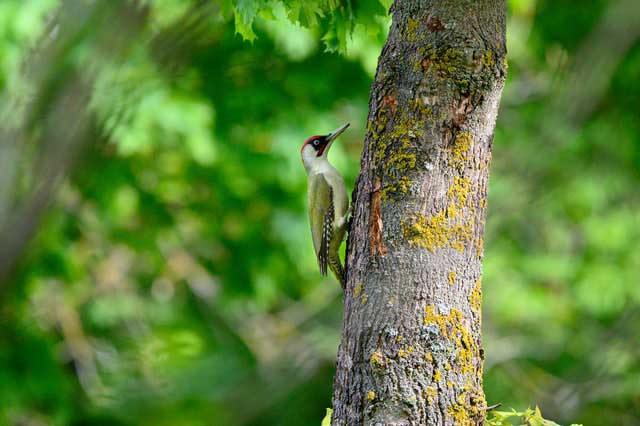
For the 9th spot in our list, we have the green woodpecker, which has an average length of 4 inches. They are native to most of Western Europe, particularly The UK, Spain and Portugal.
The primary food source of Green Wood Pecker are ants, which it hunts down using its sticky tongue, which is coated sticky secretions that it uses to get these ants. It spends most of its time searching for these ants on soft bark trees and forest floors where they can be found in abundance. Due to the long length of its tongue relative to body size, the Green Wood Pecker has to ability to wrap its tongue around its head.
#8. LONG-BEAKED ECHIDNA(7 INCHES).
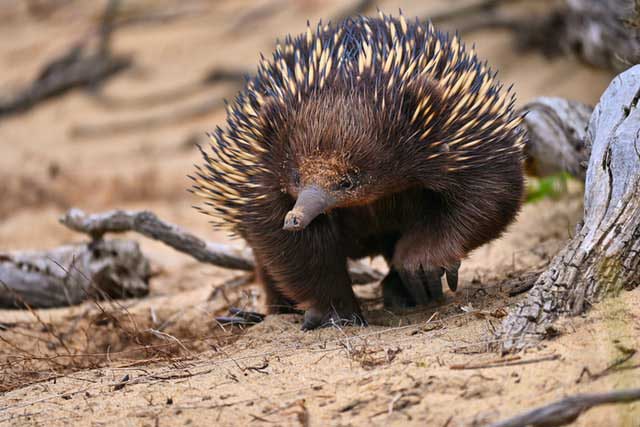
For the 8th spot on our list, we have the Echidna, also known as spiny anteaters, which has an average tongue length of 7 inches. They are native to Australia and New Guinea and tend to live in caves to protect themselves from the extreme weather conditions.
The Echidnas are solitary toothless animals with very small jaws, so they use their very long tongue, which is coated with sticky substances to catch unto prey. They feed mostly on ants, worms, and larvae.
#7. SUN BEAR(9.8 INCHES)
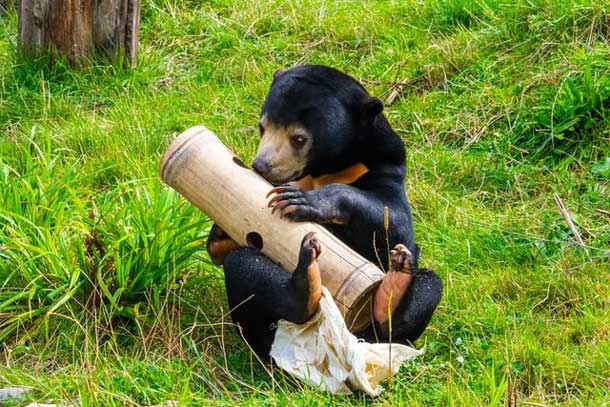
For the 7th spot on our list, we have the Sun Bear with has an average tongue length of 9.8 inches. This bear gets its name due to its highly visible orange coloured patch which is seen on its chest. They are native to Vietnam, Thailand, and Indonesia.
They are the smallest and the most tree living species of all bears and this suits them just fine as this enables them to use their long and sticky tongue to feed well on honey which is only found on trees and also other insects such as bees, worms, termites ants and occasionally bird eggs. Due to their tree living lifestyle, Sunbears are solitary, shy and excellent tree climbers. Sun bears are becoming an endangered species due to deforestation in their habitat.
#6. OKAPI (16 INCHES)
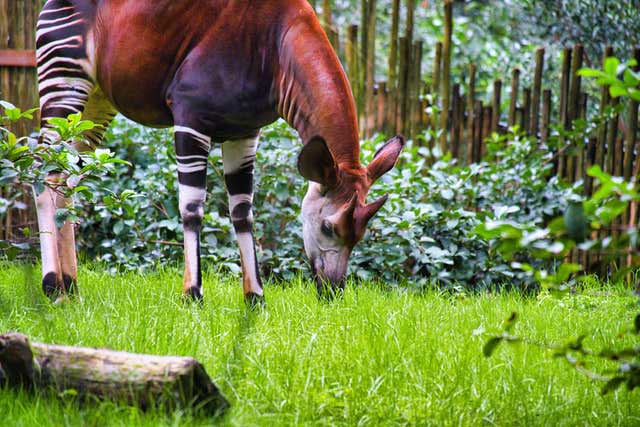
For the 6th spot on our list, we have the Okapi, also known as the zebra giraffe or Congolese giraffe, which has an average tongue length of 16 inches. They are native to the Democratic Republic of Congo, Central Africa.
The Okapi are generally solitary creatures and only come together to breed. They are herbivorous animals and usually use their long tongues to pluck out tree leaves and fruits from high reaching branches and vines. They also feed on grasses sometimes. The okapis also participate in grooming activities, using their long tongues to clean their hard to reach eyes and ears off of dirt.
#5. GIRAFFE (21 INCHES)

For the 5th spot on our list, we have the giraffe, which has an average tongue length of 21 inches. They are native to the African Continent.
Giraffes are known as the tallest living mammals on planet earth with the males being taller than the females. This added height advantage with their extremely long tongues enables them to feed on the leaves and fruits of really tall trees. Amazingly enough, the tongue of a giraffe is covered with very thick papillae which helps protect it from dangerous thorns and bristles it might encounter. Giraffes also participate in grooming using their long tongues to clean hard to reach areas of their eyes, nose and face from dirt. The colour of their tongues is of a dark-pinkish shade as it helps protect it from sun-burns.
#4. GIANT ANT EATER (24 INCHES).
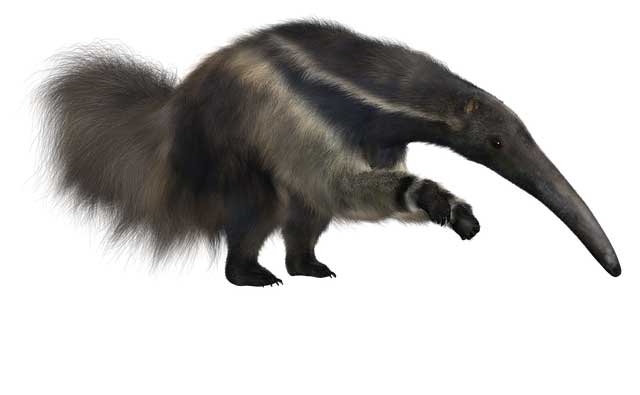
For the 4th spot on our list, we have the Giant Anteater, also known as the Ant Bear, which has an average tongue length of 24 inches. They are native to both Central and South Africa.
The Giant Anteater is an insectivorous animal and, as its name suggests, feeds mainly on ants but also on termites. They achieve this using their extremely long and sticky tongues to slurp up the insects from their nests after breaking the nests up with their long and powerful claws. They can consume as much as 30,000 ants daily and use their sense of smell to usually track them down. Also, they have very limited jaw movement, so they rely on the rotation of their lower jaw to open and close their mouths.
#3 GIANT PANGOLIN (27.5 INCHES)

For the 3rd spot on our list, we have the Giant Pangolin, also known as scaly anteater, which has an average tongue length of 27.5 inches. They are native to both Asia and Sub-Saharan Africa.
Pangolins are insectivorous animals that feed mainly on ants, termites and other insect larvae. They achieve this by probing their extremely long and sticky coated tongue into insect burrows and along trees barks to gather up these insects. On average, they can feed on 140-200g of insects daily. Pangolins also have a very poor sense of sight, so they rely on their sense of smell and hearing to track down these insects. Pangolins lack teeth, so in order to grind down their food, they rely on the stones gathered alongside the insects which they get while foraging, to help grind down their food.
#2. CHAMELEON(48 INCHES)
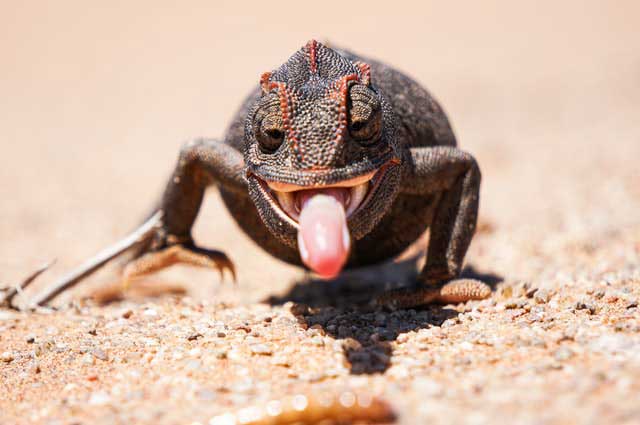
For the 2nd spot on our list we have the Chameleon, which has an average tongue length of 48 inches. They are native across various continents and live iN environments ranging from rainforests to deserts.
Chameleons can be said to have the most popular tongue in the world as it is often televised how long the length of a chameleon is. The length of the chameleon is so long that it is often almost double the length of the creature when fully extended, excluding the tail, with the smaller chameleons having a longer tongue length than the larger ones. All chameleons are insectivores feeding mainly on insects and sometimes lizards and birds around them. They achieve this by shooting their powerful tongues towards their targets at speeds of up to less than 1 second and then grabbing a hold of it with their cup-like tipped tongue.
#1.WHALE(218 INCHES OR THE SIZE OF AN AFRICAN ELEPHANT)
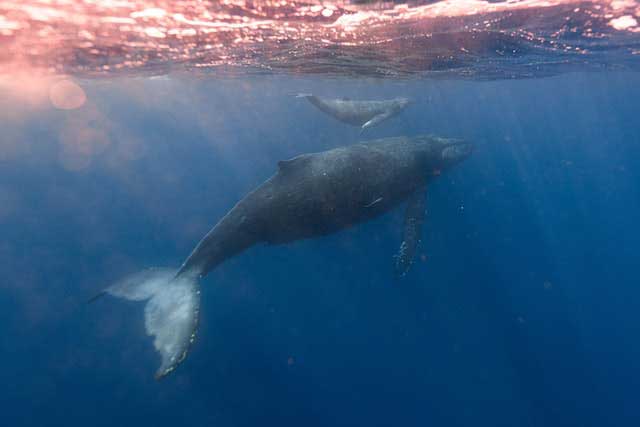
For the 1st spot on our list we the Blue Whale, which has an average length of 218 inches or more accurately the size of an adult African Elephant. They are native to all of earth’s ocean until they were nearly rendered extinct by whalers in the 20th century. The whaling acts were abolished in the 1960s to preserve the creatures.
Blue whales feed mainly krill at depths of up to 200 metres. They achieve this by swimming towards their prey at high speeds and swallowing them up, then using the pressure from their large tongue and powerful throat to separate the krill from the water, and then swallowing the leftover krill.
Thank you for reading this week’s version of THEWORLDRANKING we love having you read our, articles, if you’re interested we have other articles which might interest, you such as top 10 largest dog breeds, top 10 most powerful animal bite force or this top 10 fastest insects in the world

